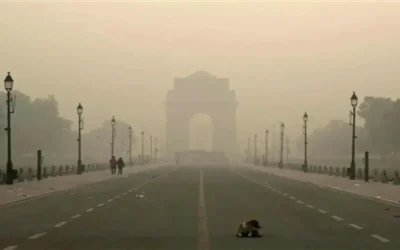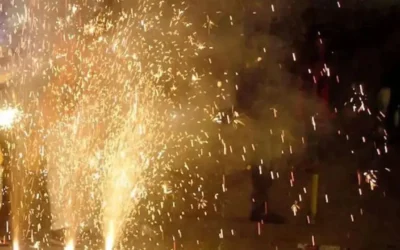Diwali 2025: Wear masks! Mumbai docs warn about effects of festive air pollution
Diwali is here along with its festivities that not only include delicious food and drink, but also the firecrackers, which have become an inseparable part of the celebrations. Unfortunately, even as the experience of lighting them brings out the inner child in us, they affect our health in more than one way. They not only bring with them the noise pollution that startle animals, but also the smoke that actually has adverse effects on people’s health, and makes it worse for those with pre-existing respiratory problems.
Mumbai doctors say they aren’t the only ones affected during this time of the year, but it is also the children, who have lungs that are still growing, but also the elderly and pregnant women, who are also vulnerable during this time of the year.
With Diwali underway and firecrackers being burst around us, mid-day spoke to Dr Amit Saraf, director, Internal Medicine, Jupiter Hospital, Thane, and Dr Harish Chafle, senior consultant Chest Physician, Bronchoscopists, Intensivist and Sleep Disorders specialist, Gleneagles Hospitals in Parel to understand the effects of air pollution on the body during Diwali. They not only highlight how dangerous it is but also the causes and effects, along with easy tips to follow during this time of the year.
How dangerous is the pollution during Diwali for people in general?
Saraf: The pollution levels during Diwali surge rapidly merely hours after bursting firecrackers. The air becomes thick with smoke, fine dust, and other dangerous compounds, potentially reaching in the “severe” level on air quality indices. This spike can affect anyone, individuals who are healthy included. Air pollution lingers in the air for days, turning joyous and festive nights into challenging periods for being able to breath and feel well.
Chafle: The loud noise during Diwali is often accompanied by smoke, fine dust, and toxic fumes from firecrackers, which irritate the airways and reduce lung function. This can trigger coughing, breathlessness, or asthma attacks, especially in those with pre-existing respiratory issues. The combined effect of noise and air pollution puts added stress on the lungs and overall health.
What kinds of health problems can people face during this period?
Saraf: Many individuals notice burning or watery eyes, coughing, throat discomfort or tickling, headaches, fatigue, and/or shortness of breath. Individuals who have asthma, bronchitis, COPD, heart disease, or allergies are likely to have an exacerbation of their conditions. However, even those without a history of illness will still feel temporary irritation or worse due to the sudden drop in air quality.
Chafle: During Diwali, the air quality often drops drastically due to smoke and particulate matter from firecrackers. This can lead to a spike in respiratory illnesses such as asthma attacks, allergic bronchitis, chronic cough, throat irritation, and breathlessness. People with COPD or lung infections may experience worsening symptoms, while even healthy individuals can develop temporary inflammation in the airways or reduced lung capacity.
Which age groups and gender are the most vulnerable, and why?
Saraf: The most affected groups are children, the elderly, and pregnant women. Children tend to breathe faster, and their lungs are still growing, increasing their exposure to pollution; in addition, older adults often have immunosuppression and/or may live with chronic conditions. Pregnant women may experience further congestion because pregnancy decreases lung capacity.
Chafle: Children and the elderly are the most vulnerable, as their lungs are either developing or weakened. Prolonged exposure to smoke and pollutants can easily trigger breathing issues and asthma attacks in these groups.
How does the smoke affect those with respiratory illnesses?
Saraf: For those who suffer from respiratory illnesses, smoke from Diwali can be particularly harmful. Fine particulate matter permeates the lungs, creating inflammation and airway narrowing. Wheezing, coughing or breathlessness can develop quickly after only a short duration of exposure.
What is in Diwali pollution that makes it different from regular pollution?
Saraf: Diwali smoke contains sulphur dioxide, nitrogen oxides, heavy metals including lead and barium, and ultra-fine particles released from fireworks. All these elements create heavier smoke that is toxic and more irritating than typical urban pollution.
What simple steps can people with respiratory issues take to protect themselves?
Saraf: Staying inside during peak firecracker times, keeping the windows shut, using air purifiers, and wearing N95 masks outside can help limit exposure. Washing your face and rinsing your eyes regularly will remove any residue. Keeping inhalers and medications nearby is important in case of a prompt response.
If someone faces breathing problems during Diwali, what can people around them do immediately?
Chafle: If someone develops breathing difficulty due to smoke exposure, move them to a well-ventilated or indoor area immediately and help them take slow, deep breaths or use their inhaler if prescribed. Offer water and keep them calm until medical help arrives.
Search
Recent
- Gill blames top-order collapse after loss: ‘When you lose 3 wickets in powerplay’
- ‘An illegal drug leader’: Trump lashes out at Columbia’s prez; halts US aid to the country
- Scientists hope underwater fiber-optic cables can help save endangered orcas
- China helps Pak launch satellite: Third such mission this year – what is remote sensing satellite?
- Gill joins Kohli in unwanted captaincy record after defeat to Australia

